Home / The Cyclohexane Chair Flip
Conformations and Cycloalkanes
The Cyclohexane Chair Flip
Last updated: December 12th, 2024 |
The Cyclohexane Chair Flip
All about how to draw the product of a cyclohexane chair flip – and also, three ways not to!
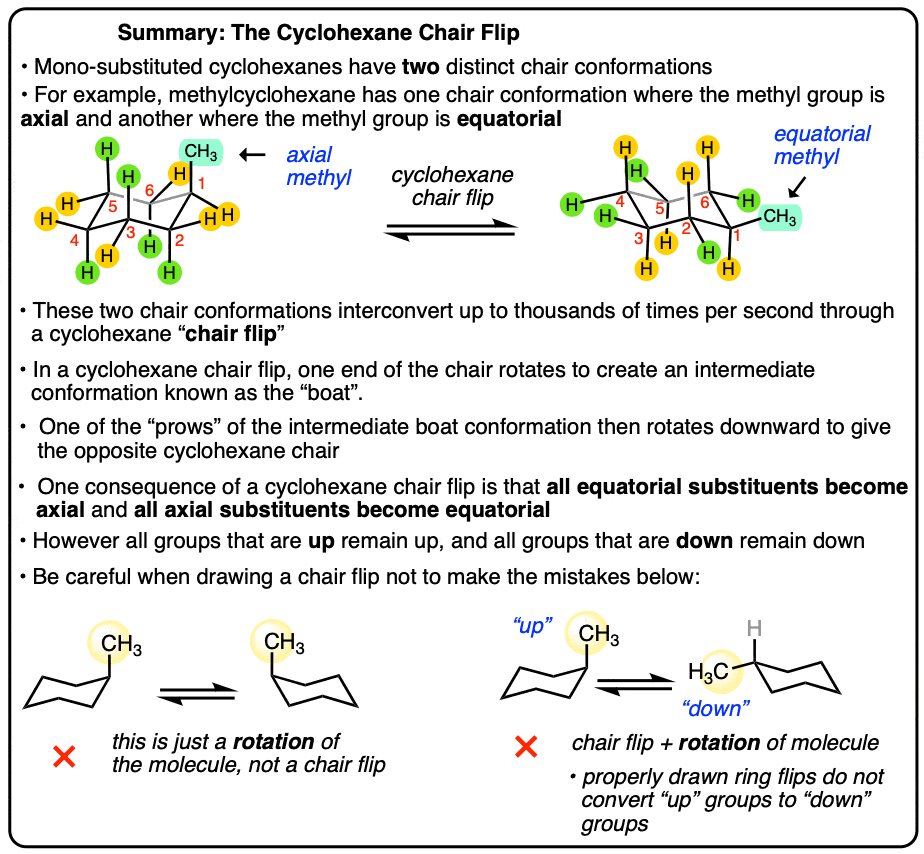
- The Two Chair Conformations of 1-Methyl Cyclohexane
- How Do These Conformations Interconvert? Through A Cyclohexane “Chair Flip”
- Step One: Bring Up A “Footrest” Of The Chair To Make a Cyclohexane “Boat”
- Step Two: Pull Down The Opposite “Headrest” Of The “Boat” To Make a Cyclohexane Chair
- The Chair Flip Converts All Axial Groups To Equatorial Groups And Vice Versa
- The Chair Flip of 1-Methylcyclohexane, Mapped out
- Three Ways NOT To Do A Cyclohexane Chair Flip
- Notes
- (Advanced) References and Further Reading
1. The Two Chair Conformations Of 1-Methyl Cyclohexane
In a recent post, an aerial tour of the cyclohexane chair, we showed that there are two different positions a substituent can occupy on a cyclohexane chair – axial (straight up and down, relative to the ring) and equatorial (off to the side of the ring).
This brings up an interesting thought experiment. Let’s take a really simple substituted version of cyclohexane – 1-methylcyclohexane, for example.
From the “dash wedge” diagram, there is only one way to depict 1-methylcyclohexane. Like this.
No matter how you rotate it, or flip it – it’s all superimposable versions of the same thing.

Now let’s draw the cyclohexane chair version. We draw a chair, and then…. hold on!
Can you see how this is a different situation? We could put the methyl group on an axial carbon or an equatorial carbon… and these are not superimposable on each other, unlike the “flat” drawing above.
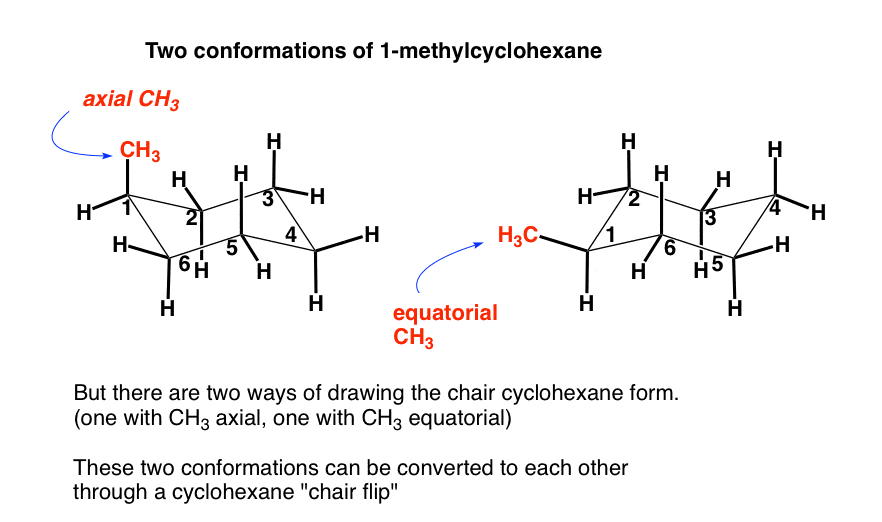
2. How Do These Conformations Interconvert? Through A Cyclohexane “Chair Flip”
Same connectivity, different shape – this is a definition of “conformational isomers” if ever there was one.
However, unlike, say, conformations in linear alkanes, which involve rotations about single bonds, it might not be immediately obvious how the chair on the left can be converted to the chair on the right.
The point of this post is to describe how these two conformations can be converted into each other, through a series of bond rotations we call a “chair flip”.
When we first introduced the cyclohexane chair, we mentioned that it was the lowest energy conformation of cyclohexane – but not the only conformation. Here’s a molecular model of cyclohexane, showing all the axial hydrogens (white) and equatorial hydrogens (red). Looked at from one perspective, we see the chair with its “head rest” on the left and “foot rest” on the right.
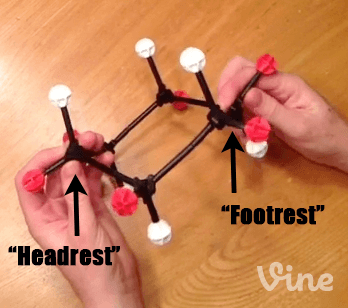
Step 1: Bring Up A “Footrest” of The Chair To Make A”Boat” Hammock
Now, if we take the “foot rest” of cyclohexane, and rotate several of the bonds, we are able to obtain a structure which looks like it has two “head rests”. This is called the “boat” [To be technical, it will actually be a “twist boat”, where there is a slight offset of the groups on the “prow”]. I am still partial to “hammock”. IUPAC, are you listening?
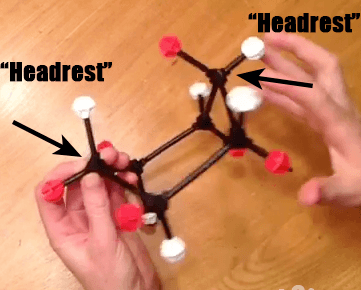
Step 2: Pull Down The Opposite Head Rest To Make A New Foot Rest
Now, if we take the “original” head rest (on the left) and pull it down, so that it makes a new “foot rest”, we have the following.
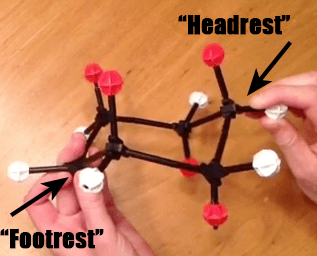
Your first thought might be – that’s pretty useless! Who cares if we just start with a cyclohexane chair and convert it into another cyclohexane chair. That’s like converting a dollar bill into four quarters and then exchanging them back into a dollar bill. It’s almost like nothing happened.
5. The Chair Flip Converts All Axial Groups To Equatorial Ones, And Vice Versa
Ahh! You see – it’s not QUITE the same. In this video, watch how this model of a cyclohexane chair is first converted into a boat, and then into a new cyclohexane chair.
Here’s the molecular ballet in motion. Pay close attention to the [white] axial groups and the [red] equatorial groups. What do you see?
During this chair flip, all the axial groups become equatorial… and all the equatorial groups become axial!
Here’s another way of showing how all equatorial substituents become axial (and vice versa) from this video courtesy of OChemNinja (YouTube)
This brings us back to 1-methylcyclohexane.
6. The Chair Flip Of 1-Methylcyclohexane, Revisited
These two conformations can be converted to each other using a chair flip. Note how on C-1, “axial up” becomes “equatorial up”. That’s the right way to do it.
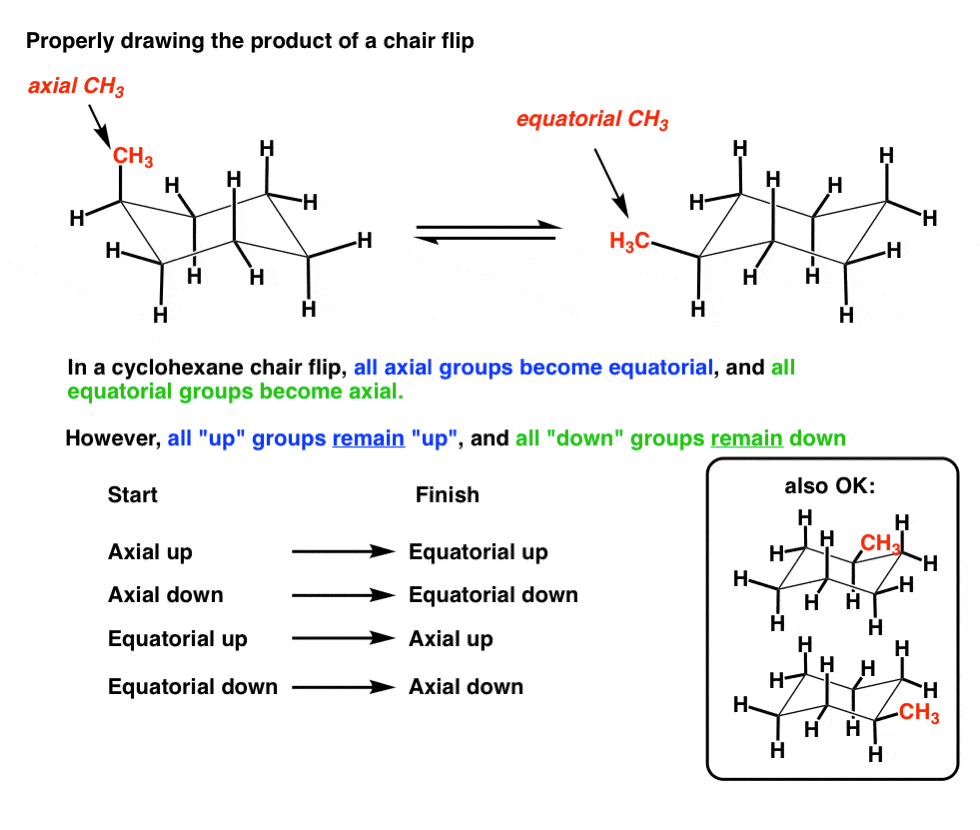
7. Three Ways NOT To Properly Do A Cyclohexane Chair Flip
This being organic chemistry, there’s plenty of ways to screw this up. Here’s a few wrong ways to draw a chair flip :
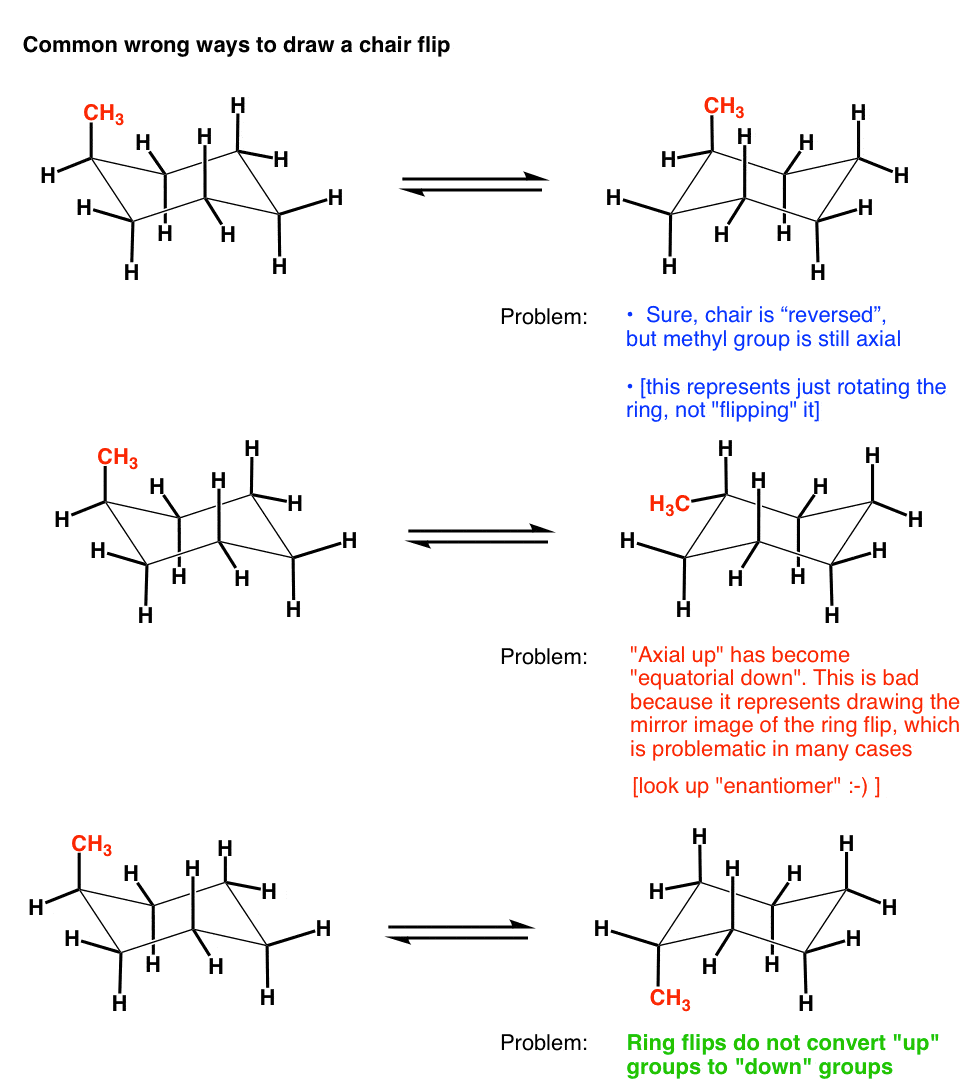
In the next post, we’ll look into this “ring flipping” process in a bit more detail. Stay tuned!
Notes
Related Articles
- The Cyclohexane Chair Flip – Energy Diagram
- Substituted Cyclohexanes – Axial vs Equatorial
- Cyclohexane Chair Conformation Stability: Which One Is Lower Energy?
- Ranking The Bulkiness Of Substituents On Cyclohexanes: “A-Values”
- Cycloalkanes – Ring Strain In Cyclopropane And Cyclobutane
- Cycloalkanes Practice Problems (MOC Membership)
(Advanced) References and Further Reading
This is a topic commonly taught to undergraduates in Organic Chemistry. Cyclohexane’s ground state conformation is the chair, and it can undergo a ring ‘flip’, where axial substituents become equatorial substituents. This flip goes through some higher-energy intermediates (the boat, half-boat, and twist-chair).
- Ueber die geometrischen Isomerien der Hexamethylenderivate
H. Sachse
Chem. Ber. 1890, 23 (1), 1363-1370
DOI: 10.1002/cber.189002301216
The conformations of cyclohexane and related six-membered rings have been of active interest since at least 1890. - Die Baeyersche Spannungstheorie und die Struktur des Diamanten
Ernst Mohr
Journal für Praktische Chemie 1918, 98 (1), 315-353
DOI: 1002/prac.19180980123
A very early paper on the 3-D model of cyclohexane, showing that it is not flat, and providing models for the chair conformation. - The conformation of the steroid nucleus
H. R. Barton
Experientia 1950, 6, 316-320
DOI: 10.1007/BF02170915
This early paper by Nobel Laureate Sir Prof. D. H. R. Barton is on the conformational analysis of cyclohexanes and later applies this to the 3-D structure of steroids (which contain several fused 6-membered rings). He notes that cyclohexane confomers can interconvert, stating, “a small difference in free energy content (about one kilocal, at room temperature) between two possible conformations will ensure that the molecule appears by physical methods of examination and by thermodynamic considerations to be substantially in only one conformation.” - Nomenclature of cycloHexane Bonds
BARTON, D., HASSEL, O., PITZER, K., PRELOG, V.
Nature 1953, 172, 1096–1097
DOI: 1038/1721096b0 - Nomenclature of Cyclohexane Bonds
H. R. Barton, O. Hassel, K. S. Pitzer, V. Prelog
Science 1954, 119, 49
DOI: 10.1126/science.119.3079.49
These are the first instances of the terms ‘axial’ and ‘equatorial’ being used to denote the two positions substituents can take in cyclohexane. This was also back in the day when scientists could safely cross-publish to get better visibility – pretty much the same article is published in both Science and Nature, considered top journals. - Nuclear Magnetic Resonance Line-Shape and Double-Resonance Studies of Ring Inversion in Cyclohexane-d11
A. L. Anet and A. J. R. Bourn
Journal of the American Chemical Society 1967, 89 (4), 760-768
DOI: 10.1021/ja00980a006
This paper covers a classic experiment and is commonly mentioned in undergraduate and graduate organic chemistry or NMR courses. At room temperature, cyclohexane gives one signal because interconversion of chair forms occurs rapidly. At low temperatures, however, it gives a very complex 1H NMR spectrum. At low temperatures interconversions are slow; the chemical shifts of the axial and equatorial protons are resolved, and complex spin-spin couplings occur. At -100 °C, however, cyclohexane-d11 gives only 2 signals of equal intensity. These signals correspond to the axial and equatorial hydrogen atoms. Interconversions between these conformations occur slowly at this low temperature, but they happen slowly enough for the NMR spectrometer to detect the individual conformations (the nucleus of a deuteron has a much smaller magnetic moment than a proton, and signals from deuteron absorption do not occur in 1H NMR spectra). Prof. F. A. L. Anet is an Emeritus Professor at UCLA and was a pioneer in the use of NMR spectroscopy for conformational analysis. - Non‐Chair Conformations of Six‐Membered Rings
M. Kellie, F. G. Riddell
Topics in Stereochemistry 1974, 8
DOI: 10.1002/9780470147177.ch3
This reference contains useful information on the inversion barrier for cyclohexane, as well being the first paper to actually invoke the ‘twist-boat’ conformation during this process. - Conformational equilibrium trapping by high-vacuum cryogenic deposition
A. L. Anet and M. Squillacote
Journal of the American Chemical Society 1975, 97 (11), 3243-3244
DOI: 10.1021/ja00844a067
The chair-twist energy difference has been directly measured by low-termperature IR spectroscopy. The chair was determined to be 5.5 kcal/mol lower in enthalpy than the twist. - Conformational structure, energy, and inversion rates of cyclohexane and some related oxanes
Herbert L. Strauss and Herbert M. Pickett
Journal of the American Chemical Society 1970, 92 (25), 7281-7290
DOI: 1021/ja00728a009
This paper describes a theoretical method for setting up calculations for ring inversion. - Conformational analysis. 130. MM2. A hydrocarbon force field utilizing V1 and V2 torsional terms
Norman L. Allinger
Journal of the American Chemical Society 1977, 99 (25), 8127-8134
DOI: 1021/ja00467a001
The MM2 (Molecular Mechanics 2) method was developed by Prof. Allinger for conformational analysis of hydrocarbons and other small organic molecules. This paper documents results for calculations using this method, including the ring inversion of cyclohexane. MM methods are considered crude nowadays because they neglect quantum and relativistic effects, but they are nonetheless useful for doing initial geometry optimization of a structure before doing a higher-level calculation.
00 General Chemistry Review
01 Bonding, Structure, and Resonance
- How Do We Know Methane (CH4) Is Tetrahedral?
- Hybrid Orbitals and Hybridization
- How To Determine Hybridization: A Shortcut
- Orbital Hybridization And Bond Strengths
- Sigma bonds come in six varieties: Pi bonds come in one
- A Key Skill: How to Calculate Formal Charge
- The Four Intermolecular Forces and How They Affect Boiling Points
- 3 Trends That Affect Boiling Points
- How To Use Electronegativity To Determine Electron Density (and why NOT to trust formal charge)
- Introduction to Resonance
- How To Use Curved Arrows To Interchange Resonance Forms
- Evaluating Resonance Forms (1) - The Rule of Least Charges
- How To Find The Best Resonance Structure By Applying Electronegativity
- Evaluating Resonance Structures With Negative Charges
- Evaluating Resonance Structures With Positive Charge
- Exploring Resonance: Pi-Donation
- Exploring Resonance: Pi-acceptors
- In Summary: Evaluating Resonance Structures
- Drawing Resonance Structures: 3 Common Mistakes To Avoid
- How to apply electronegativity and resonance to understand reactivity
- Bond Hybridization Practice
- Structure and Bonding Practice Quizzes
- Resonance Structures Practice
02 Acid Base Reactions
- Introduction to Acid-Base Reactions
- Acid Base Reactions In Organic Chemistry
- The Stronger The Acid, The Weaker The Conjugate Base
- Walkthrough of Acid-Base Reactions (3) - Acidity Trends
- Five Key Factors That Influence Acidity
- Acid-Base Reactions: Introducing Ka and pKa
- How to Use a pKa Table
- The pKa Table Is Your Friend
- A Handy Rule of Thumb for Acid-Base Reactions
- Acid Base Reactions Are Fast
- pKa Values Span 60 Orders Of Magnitude
- How Protonation and Deprotonation Affect Reactivity
- Acid Base Practice Problems
03 Alkanes and Nomenclature
- Meet the (Most Important) Functional Groups
- Condensed Formulas: Deciphering What the Brackets Mean
- Hidden Hydrogens, Hidden Lone Pairs, Hidden Counterions
- Don't Be Futyl, Learn The Butyls
- Primary, Secondary, Tertiary, Quaternary In Organic Chemistry
- Branching, and Its Affect On Melting and Boiling Points
- The Many, Many Ways of Drawing Butane
- Wedge And Dash Convention For Tetrahedral Carbon
- Common Mistakes in Organic Chemistry: Pentavalent Carbon
- Table of Functional Group Priorities for Nomenclature
- Summary Sheet - Alkane Nomenclature
- Organic Chemistry IUPAC Nomenclature Demystified With A Simple Puzzle Piece Approach
- Boiling Point Quizzes
- Organic Chemistry Nomenclature Quizzes
04 Conformations and Cycloalkanes
- Staggered vs Eclipsed Conformations of Ethane
- Conformational Isomers of Propane
- Newman Projection of Butane (and Gauche Conformation)
- Introduction to Cycloalkanes
- Geometric Isomers In Small Rings: Cis And Trans Cycloalkanes
- Calculation of Ring Strain In Cycloalkanes
- Cycloalkanes - Ring Strain In Cyclopropane And Cyclobutane
- Cyclohexane Conformations
- Cyclohexane Chair Conformation: An Aerial Tour
- How To Draw The Cyclohexane Chair Conformation
- The Cyclohexane Chair Flip
- The Cyclohexane Chair Flip - Energy Diagram
- Substituted Cyclohexanes - Axial vs Equatorial
- Ranking The Bulkiness Of Substituents On Cyclohexanes: "A-Values"
- Cyclohexane Chair Conformation Stability: Which One Is Lower Energy?
- Fused Rings - Cis-Decalin and Trans-Decalin
- Naming Bicyclic Compounds - Fused, Bridged, and Spiro
- Bredt's Rule (And Summary of Cycloalkanes)
- Newman Projection Practice
- Cycloalkanes Practice Problems
05 A Primer On Organic Reactions
- The Most Important Question To Ask When Learning a New Reaction
- Curved Arrows (for reactions)
- Nucleophiles and Electrophiles
- The Three Classes of Nucleophiles
- Nucleophilicity vs. Basicity
- What Makes A Good Nucleophile?
- What Makes A Good Leaving Group?
- 3 Factors That Stabilize Carbocations
- Equilibrium and Energy Relationships
- 7 Factors that stabilize negative charge in organic chemistry
- 7 Factors That Stabilize Positive Charge in Organic Chemistry
- What's a Transition State?
- Hammond's Postulate
- Learning Organic Chemistry Reactions: A Checklist (PDF)
- Introduction to Oxidative Cleavage Reactions
06 Free Radical Reactions
- Bond Dissociation Energies = Homolytic Cleavage
- Free Radical Reactions
- 3 Factors That Stabilize Free Radicals
- What Factors Destabilize Free Radicals?
- Bond Strengths And Radical Stability
- Free Radical Initiation: Why Is "Light" Or "Heat" Required?
- Initiation, Propagation, Termination
- Monochlorination Products Of Propane, Pentane, And Other Alkanes
- Selectivity In Free Radical Reactions
- Selectivity in Free Radical Reactions: Bromination vs. Chlorination
- Halogenation At Tiffany's
- Allylic Bromination
- Bonus Topic: Allylic Rearrangements
- In Summary: Free Radicals
- Synthesis (2) - Reactions of Alkanes
- Free Radicals Practice Quizzes
07 Stereochemistry and Chirality
- Types of Isomers: Constitutional Isomers, Stereoisomers, Enantiomers, and Diastereomers
- How To Draw The Enantiomer Of A Chiral Molecule
- How To Draw A Bond Rotation
- Introduction to Assigning (R) and (S): The Cahn-Ingold-Prelog Rules
- Assigning Cahn-Ingold-Prelog (CIP) Priorities (2) - The Method of Dots
- Enantiomers vs Diastereomers vs The Same? Two Methods For Solving Problems
- Assigning R/S To Newman Projections (And Converting Newman To Line Diagrams)
- How To Determine R and S Configurations On A Fischer Projection
- The Meso Trap
- Optical Rotation, Optical Activity, and Specific Rotation
- Optical Purity and Enantiomeric Excess
- What's a Racemic Mixture?
- Chiral Allenes And Chiral Axes
- Stereochemistry Practice Problems and Quizzes
08 Substitution Reactions
- Nucleophilic Substitution Reactions - Introduction
- Two Types of Nucleophilic Substitution Reactions
- The SN2 Mechanism
- Why the SN2 Reaction Is Powerful
- The SN1 Mechanism
- The Conjugate Acid Is A Better Leaving Group
- Comparing the SN1 and SN2 Reactions
- Polar Protic? Polar Aprotic? Nonpolar? All About Solvents
- Steric Hindrance is Like a Fat Goalie
- Common Blind Spot: Intramolecular Reactions
- Substitution Practice - SN1
- Substitution Practice - SN2
09 Elimination Reactions
- Elimination Reactions (1): Introduction And The Key Pattern
- Elimination Reactions (2): The Zaitsev Rule
- Elimination Reactions Are Favored By Heat
- Two Elimination Reaction Patterns
- The E1 Reaction
- The E2 Mechanism
- E1 vs E2: Comparing the E1 and E2 Reactions
- Antiperiplanar Relationships: The E2 Reaction and Cyclohexane Rings
- Bulky Bases in Elimination Reactions
- Comparing the E1 vs SN1 Reactions
- Elimination (E1) Reactions With Rearrangements
- E1cB - Elimination (Unimolecular) Conjugate Base
- Elimination (E1) Practice Problems And Solutions
- Elimination (E2) Practice Problems and Solutions
10 Rearrangements
11 SN1/SN2/E1/E2 Decision
- Identifying Where Substitution and Elimination Reactions Happen
- Deciding SN1/SN2/E1/E2 (1) - The Substrate
- Deciding SN1/SN2/E1/E2 (2) - The Nucleophile/Base
- SN1 vs E1 and SN2 vs E2 : The Temperature
- Deciding SN1/SN2/E1/E2 - The Solvent
- Wrapup: The Key Factors For Determining SN1/SN2/E1/E2
- Alkyl Halide Reaction Map And Summary
- SN1 SN2 E1 E2 Practice Problems
12 Alkene Reactions
- E and Z Notation For Alkenes (+ Cis/Trans)
- Alkene Stability
- Alkene Addition Reactions: "Regioselectivity" and "Stereoselectivity" (Syn/Anti)
- Stereoselective and Stereospecific Reactions
- Hydrohalogenation of Alkenes and Markovnikov's Rule
- Hydration of Alkenes With Aqueous Acid
- Rearrangements in Alkene Addition Reactions
- Halogenation of Alkenes and Halohydrin Formation
- Oxymercuration Demercuration of Alkenes
- Hydroboration Oxidation of Alkenes
- m-CPBA (meta-chloroperoxybenzoic acid)
- OsO4 (Osmium Tetroxide) for Dihydroxylation of Alkenes
- Palladium on Carbon (Pd/C) for Catalytic Hydrogenation of Alkenes
- Cyclopropanation of Alkenes
- A Fourth Alkene Addition Pattern - Free Radical Addition
- Alkene Reactions: Ozonolysis
- Summary: Three Key Families Of Alkene Reaction Mechanisms
- Synthesis (4) - Alkene Reaction Map, Including Alkyl Halide Reactions
- Alkene Reactions Practice Problems
13 Alkyne Reactions
- Acetylides from Alkynes, And Substitution Reactions of Acetylides
- Partial Reduction of Alkynes With Lindlar's Catalyst
- Partial Reduction of Alkynes With Na/NH3 To Obtain Trans Alkenes
- Alkyne Hydroboration With "R2BH"
- Hydration and Oxymercuration of Alkynes
- Hydrohalogenation of Alkynes
- Alkyne Halogenation: Bromination, Chlorination, and Iodination of Alkynes
- Alkyne Reactions - The "Concerted" Pathway
- Alkenes To Alkynes Via Halogenation And Elimination Reactions
- Alkynes Are A Blank Canvas
- Synthesis (5) - Reactions of Alkynes
- Alkyne Reactions Practice Problems With Answers
14 Alcohols, Epoxides and Ethers
- Alcohols - Nomenclature and Properties
- Alcohols Can Act As Acids Or Bases (And Why It Matters)
- Alcohols - Acidity and Basicity
- The Williamson Ether Synthesis
- Ethers From Alkenes, Tertiary Alkyl Halides and Alkoxymercuration
- Alcohols To Ethers via Acid Catalysis
- Cleavage Of Ethers With Acid
- Epoxides - The Outlier Of The Ether Family
- Opening of Epoxides With Acid
- Epoxide Ring Opening With Base
- Making Alkyl Halides From Alcohols
- Tosylates And Mesylates
- PBr3 and SOCl2
- Elimination Reactions of Alcohols
- Elimination of Alcohols To Alkenes With POCl3
- Alcohol Oxidation: "Strong" and "Weak" Oxidants
- Demystifying The Mechanisms of Alcohol Oxidations
- Protecting Groups For Alcohols
- Thiols And Thioethers
- Calculating the oxidation state of a carbon
- Oxidation and Reduction in Organic Chemistry
- Oxidation Ladders
- SOCl2 Mechanism For Alcohols To Alkyl Halides: SN2 versus SNi
- Alcohol Reactions Roadmap (PDF)
- Alcohol Reaction Practice Problems
- Epoxide Reaction Quizzes
- Oxidation and Reduction Practice Quizzes
15 Organometallics
- What's An Organometallic?
- Formation of Grignard and Organolithium Reagents
- Organometallics Are Strong Bases
- Reactions of Grignard Reagents
- Protecting Groups In Grignard Reactions
- Synthesis Problems Involving Grignard Reagents
- Grignard Reactions And Synthesis (2)
- Organocuprates (Gilman Reagents): How They're Made
- Gilman Reagents (Organocuprates): What They're Used For
- The Heck, Suzuki, and Olefin Metathesis Reactions (And Why They Don't Belong In Most Introductory Organic Chemistry Courses)
- Reaction Map: Reactions of Organometallics
- Grignard Practice Problems
16 Spectroscopy
- Degrees of Unsaturation (or IHD, Index of Hydrogen Deficiency)
- Conjugation And Color (+ How Bleach Works)
- Introduction To UV-Vis Spectroscopy
- UV-Vis Spectroscopy: Absorbance of Carbonyls
- UV-Vis Spectroscopy: Practice Questions
- Bond Vibrations, Infrared Spectroscopy, and the "Ball and Spring" Model
- Infrared Spectroscopy: A Quick Primer On Interpreting Spectra
- IR Spectroscopy: 4 Practice Problems
- 1H NMR: How Many Signals?
- Homotopic, Enantiotopic, Diastereotopic
- Diastereotopic Protons in 1H NMR Spectroscopy: Examples
- 13-C NMR - How Many Signals
- Liquid Gold: Pheromones In Doe Urine
- Natural Product Isolation (1) - Extraction
- Natural Product Isolation (2) - Purification Techniques, An Overview
- Structure Determination Case Study: Deer Tarsal Gland Pheromone
17 Dienes and MO Theory
- What To Expect In Organic Chemistry 2
- Are these molecules conjugated?
- Conjugation And Resonance In Organic Chemistry
- Bonding And Antibonding Pi Orbitals
- Molecular Orbitals of The Allyl Cation, Allyl Radical, and Allyl Anion
- Pi Molecular Orbitals of Butadiene
- Reactions of Dienes: 1,2 and 1,4 Addition
- Thermodynamic and Kinetic Products
- More On 1,2 and 1,4 Additions To Dienes
- s-cis and s-trans
- The Diels-Alder Reaction
- Cyclic Dienes and Dienophiles in the Diels-Alder Reaction
- Stereochemistry of the Diels-Alder Reaction
- Exo vs Endo Products In The Diels Alder: How To Tell Them Apart
- HOMO and LUMO In the Diels Alder Reaction
- Why Are Endo vs Exo Products Favored in the Diels-Alder Reaction?
- Diels-Alder Reaction: Kinetic and Thermodynamic Control
- The Retro Diels-Alder Reaction
- The Intramolecular Diels Alder Reaction
- Regiochemistry In The Diels-Alder Reaction
- The Cope and Claisen Rearrangements
- Electrocyclic Reactions
- Electrocyclic Ring Opening And Closure (2) - Six (or Eight) Pi Electrons
- Diels Alder Practice Problems
- Molecular Orbital Theory Practice
18 Aromaticity
- Introduction To Aromaticity
- Rules For Aromaticity
- Huckel's Rule: What Does 4n+2 Mean?
- Aromatic, Non-Aromatic, or Antiaromatic? Some Practice Problems
- Antiaromatic Compounds and Antiaromaticity
- The Pi Molecular Orbitals of Benzene
- The Pi Molecular Orbitals of Cyclobutadiene
- Frost Circles
- Aromaticity Practice Quizzes
19 Reactions of Aromatic Molecules
- Electrophilic Aromatic Substitution: Introduction
- Activating and Deactivating Groups In Electrophilic Aromatic Substitution
- Electrophilic Aromatic Substitution - The Mechanism
- Ortho-, Para- and Meta- Directors in Electrophilic Aromatic Substitution
- Understanding Ortho, Para, and Meta Directors
- Why are halogens ortho- para- directors?
- Disubstituted Benzenes: The Strongest Electron-Donor "Wins"
- Electrophilic Aromatic Substitutions (1) - Halogenation of Benzene
- Electrophilic Aromatic Substitutions (2) - Nitration and Sulfonation
- EAS Reactions (3) - Friedel-Crafts Acylation and Friedel-Crafts Alkylation
- Intramolecular Friedel-Crafts Reactions
- Nucleophilic Aromatic Substitution (NAS)
- Nucleophilic Aromatic Substitution (2) - The Benzyne Mechanism
- Reactions on the "Benzylic" Carbon: Bromination And Oxidation
- The Wolff-Kishner, Clemmensen, And Other Carbonyl Reductions
- More Reactions on the Aromatic Sidechain: Reduction of Nitro Groups and the Baeyer Villiger
- Aromatic Synthesis (1) - "Order Of Operations"
- Synthesis of Benzene Derivatives (2) - Polarity Reversal
- Aromatic Synthesis (3) - Sulfonyl Blocking Groups
- Birch Reduction
- Synthesis (7): Reaction Map of Benzene and Related Aromatic Compounds
- Aromatic Reactions and Synthesis Practice
- Electrophilic Aromatic Substitution Practice Problems
20 Aldehydes and Ketones
- What's The Alpha Carbon In Carbonyl Compounds?
- Nucleophilic Addition To Carbonyls
- Aldehydes and Ketones: 14 Reactions With The Same Mechanism
- Sodium Borohydride (NaBH4) Reduction of Aldehydes and Ketones
- Grignard Reagents For Addition To Aldehydes and Ketones
- Wittig Reaction
- Hydrates, Hemiacetals, and Acetals
- Imines - Properties, Formation, Reactions, and Mechanisms
- All About Enamines
- Breaking Down Carbonyl Reaction Mechanisms: Reactions of Anionic Nucleophiles (Part 2)
- Aldehydes Ketones Reaction Practice
21 Carboxylic Acid Derivatives
- Nucleophilic Acyl Substitution (With Negatively Charged Nucleophiles)
- Addition-Elimination Mechanisms With Neutral Nucleophiles (Including Acid Catalysis)
- Basic Hydrolysis of Esters - Saponification
- Transesterification
- Proton Transfer
- Fischer Esterification - Carboxylic Acid to Ester Under Acidic Conditions
- Lithium Aluminum Hydride (LiAlH4) For Reduction of Carboxylic Acid Derivatives
- LiAlH[Ot-Bu]3 For The Reduction of Acid Halides To Aldehydes
- Di-isobutyl Aluminum Hydride (DIBAL) For The Partial Reduction of Esters and Nitriles
- Amide Hydrolysis
- Thionyl Chloride (SOCl2) And Conversion of Carboxylic Acids to Acid Halides
- Diazomethane (CH2N2)
- Carbonyl Chemistry: Learn Six Mechanisms For the Price Of One
- Making Music With Mechanisms (PADPED)
- Carboxylic Acid Derivatives Practice Questions
22 Enols and Enolates
- Keto-Enol Tautomerism
- Enolates - Formation, Stability, and Simple Reactions
- Kinetic Versus Thermodynamic Enolates
- Aldol Addition and Condensation Reactions
- Reactions of Enols - Acid-Catalyzed Aldol, Halogenation, and Mannich Reactions
- Claisen Condensation and Dieckmann Condensation
- Decarboxylation
- The Malonic Ester and Acetoacetic Ester Synthesis
- The Michael Addition Reaction and Conjugate Addition
- The Robinson Annulation
- Haloform Reaction
- The Hell–Volhard–Zelinsky Reaction
- Enols and Enolates Practice Quizzes
23 Amines
- The Amide Functional Group: Properties, Synthesis, and Nomenclature
- Basicity of Amines And pKaH
- 5 Key Basicity Trends of Amines
- The Mesomeric Effect And Aromatic Amines
- Nucleophilicity of Amines
- Alkylation of Amines (Sucks!)
- Reductive Amination
- The Gabriel Synthesis
- Some Reactions of Azides
- The Hofmann Elimination
- The Hofmann and Curtius Rearrangements
- The Cope Elimination
- Protecting Groups for Amines - Carbamates
- The Strecker Synthesis of Amino Acids
- Introduction to Peptide Synthesis
- Reactions of Diazonium Salts: Sandmeyer and Related Reactions
- Amine Practice Questions
24 Carbohydrates
- D and L Notation For Sugars
- Pyranoses and Furanoses: Ring-Chain Tautomerism In Sugars
- What is Mutarotation?
- Reducing Sugars
- The Big Damn Post Of Carbohydrate-Related Chemistry Definitions
- The Haworth Projection
- Converting a Fischer Projection To A Haworth (And Vice Versa)
- Reactions of Sugars: Glycosylation and Protection
- The Ruff Degradation and Kiliani-Fischer Synthesis
- Isoelectric Points of Amino Acids (and How To Calculate Them)
- Carbohydrates Practice
- Amino Acid Quizzes
25 Fun and Miscellaneous
- A Gallery of Some Interesting Molecules From Nature
- Screw Organic Chemistry, I'm Just Going To Write About Cats
- On Cats, Part 1: Conformations and Configurations
- On Cats, Part 2: Cat Line Diagrams
- On Cats, Part 4: Enantiocats
- On Cats, Part 6: Stereocenters
- Organic Chemistry Is Shit
- The Organic Chemistry Behind "The Pill"
- Maybe they should call them, "Formal Wins" ?
- Why Do Organic Chemists Use Kilocalories?
- The Principle of Least Effort
- Organic Chemistry GIFS - Resonance Forms
- Reproducibility In Organic Chemistry
- What Holds The Nucleus Together?
- How Reactions Are Like Music
- Organic Chemistry and the New MCAT
26 Organic Chemistry Tips and Tricks
- Common Mistakes: Formal Charges Can Mislead
- Partial Charges Give Clues About Electron Flow
- Draw The Ugly Version First
- Organic Chemistry Study Tips: Learn the Trends
- The 8 Types of Arrows In Organic Chemistry, Explained
- Top 10 Skills To Master Before An Organic Chemistry 2 Final
- Common Mistakes with Carbonyls: Carboxylic Acids... Are Acids!
- Planning Organic Synthesis With "Reaction Maps"
- Alkene Addition Pattern #1: The "Carbocation Pathway"
- Alkene Addition Pattern #2: The "Three-Membered Ring" Pathway
- Alkene Addition Pattern #3: The "Concerted" Pathway
- Number Your Carbons!
- The 4 Major Classes of Reactions in Org 1
- How (and why) electrons flow
- Grossman's Rule
- Three Exam Tips
- A 3-Step Method For Thinking Through Synthesis Problems
- Putting It Together
- Putting Diels-Alder Products in Perspective
- The Ups and Downs of Cyclohexanes
- The Most Annoying Exceptions in Org 1 (Part 1)
- The Most Annoying Exceptions in Org 1 (Part 2)
- The Marriage May Be Bad, But the Divorce Still Costs Money
- 9 Nomenclature Conventions To Know
- Nucleophile attacks Electrophile
27 Case Studies of Successful O-Chem Students
- Success Stories: How Corina Got The The "Hard" Professor - And Got An A+ Anyway
- How Helena Aced Organic Chemistry
- From a "Drop" To B+ in Org 2 – How A Hard Working Student Turned It Around
- How Serge Aced Organic Chemistry
- Success Stories: How Zach Aced Organic Chemistry 1
- Success Stories: How Kari Went From C– to B+
- How Esther Bounced Back From a "C" To Get A's In Organic Chemistry 1 And 2
- How Tyrell Got The Highest Grade In Her Organic Chemistry Course
- This Is Why Students Use Flashcards
- Success Stories: How Stu Aced Organic Chemistry
- How John Pulled Up His Organic Chemistry Exam Grades
- Success Stories: How Nathan Aced Organic Chemistry (Without It Taking Over His Life)
- How Chris Aced Org 1 and Org 2
- Interview: How Jay Got an A+ In Organic Chemistry
- How to Do Well in Organic Chemistry: One Student's Advice
- "America's Top TA" Shares His Secrets For Teaching O-Chem
- "Organic Chemistry Is Like..." - A Few Metaphors
- How To Do Well In Organic Chemistry: Advice From A Tutor
- Guest post: "I went from being afraid of tests to actually looking forward to them".
Is a ring flip just another way of saying chair flip?
Yes – ring flip, chair flip, same thing.
when we convert skeletal structures (with stereochemistry) to chair conformation, is there a rule that axial means out of paper (wedge) and equatorial means into paper (dash)? Or does it depend, like axial up & equatorial up means out of paper (wedge), and axial down & equatorial down means into paper (dash)? Thanks :-)
“Down” means dash and “Up” means wedge.
It’s possible for groups that are ‘up’ (wedged) to be axial *or* equatorial. Likewise, groups that are down can also be axial *or* equatorial.
https://www.masterorganicchemistry.com/2014/05/14/an-aerial-tour-of-the-cyclohexane-chair/#eight
Wow am happy this website has been a source of inspiration to me as it help me soft some difficult chemistry problem thanks
Great, thank you.
Thank you so much this website has helped me so much
Great, thank you Erika.
Superb
Wow! This is so helpful. I’m so grateful that someone created this resource for free- this is better than ANY textbook that I’ve ever seen….a truly exceptional set of explanations.
Hey James,
Just wanted to say thanks for putting all this up, I found it really helpful.
Josh
Hey james
Want to say thank you alot for your work .
Hey James, great post! In addition to the video, there’s also an interactive movie of a cyclohexane chair flip on the CWC website: http://web.chemdoodle.com/tutorial/3d-structure-canvases/moviecanvas3d
You can copy the code shown, and also link the CWC JS file from here: http://web.chemdoodle.com/installation/download
Best!